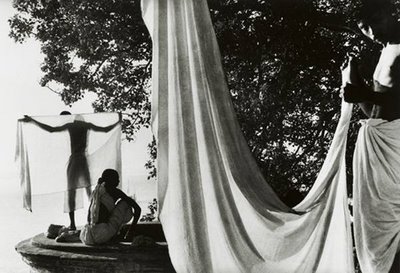
Benares, India, 1956
Gelatin silver print, printed later.
8 x 12 ½ in. (23 x 31.1 cm).
Gelatin silver print, printed later.
8 x 12 ½ in. (23 x 31.1 cm).
It was at the age of 14 that Marc Riboud took his first photographs with his father's Vest Pocket Kodak. The camera proved to be a lifelong license to roam, investigate, analyze and appreciate our multi-faceted world. An engineer by training and trade, Marc Riboud, at an early juncture in his career, took a week off from work for the exclusive purpose of taking pictures. This fateful seven day excursion of picture-taking ignited a wanderlust & he consequently never returned to the factory that confined him.
Everything Riboud was to learn about the job of photographing came from the famed Magnum crew, comprised of Henri Cartier-Bresson, Robert Capa, and Chim (David Seymour). He met the troupe in 1951 and was taken under the wing of Cartier-Bresson, who emphasized in his teachings the intricacies and make-up of composition. (Oddly, it is learned that, Cartier-Bresson "forbade" Riboud to leave his engineering position at the factory for the sake of Photography.) In 1953, Riboud became an official member of the Magnum Agency and eventually become one of its officers.
Between 1955 and 1986, Marc Riboud would travel the globe. Unlike many photojournalists whose visitations generally extend only within the confines of their given assignment, Riboud on the other hand took the proverbial stroll. From 1955-1960 he would travel the Near East, the Far East, India, Nepal, China, the Soviet Union, and take a motor tour from Alaska to Mexico. He spent 1960-1970 documenting the people and activities in Africa, Algeria, China, North and South Vietnam, and Cambodia. Between 1970 and 1980 he would return to the Near East and the Far East and explore Poland and Czechoslovakia. In 1979 Marc Riboud left the Magnum Agency. Since that time he has revisited the breadth of Asia and Europe and eventually resettled in his homeland of France, where he lives today.
Marc Riboud has been witness to the atrocities of war (photographing from both the Vietnam and the American sides of the Vietnam War), and the apparent degradation of a culture repressed from within (China during the years of Chairman Mao's Cultural Revolution). In contrast, he has captured the graces of daily life, set in sun-drenched facets of the globe (Fès, Angkor, Acapulco, Niger, Bénarès, Shaanxi), and the lyricism of child's play in everyday Paris. A man of the world with the eye of a poet, Marc Riboud's photographs are a vignette of the lives of many; brushing against the souls of culture.
REGRESAR A LA REVISTA









